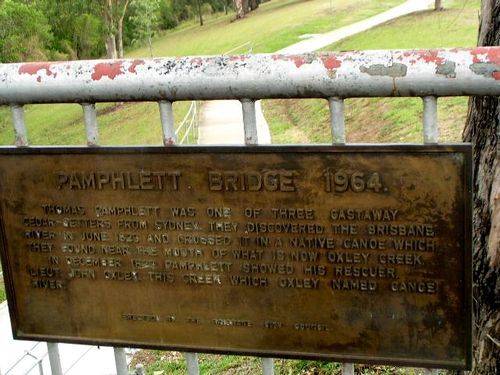
Home » Themes » People » Settlement
Thomas Pamphlett Print Page 
The bridge is named after Thomas Pamphlett, one of three castaways found by John Oxley who named the Brisbane River. In February 1964 when construction of the bridge was imminent, the Brisbane City Council agreed to a suggestion from the Tennyson Sub-Branch of the R.S.L. to call the bridge after Pamphlett. In February 1965 the Council further agreed to affix a plate to the Bridge, the wording first being submitted to the Royal Historical Society of Queensland
Thomas Pamphlett sometimes Pamphlet, also known as James Groom, was a convict in colonial Australia. He is best known for his time as a castaway in the Moreton Bay area, half way up the eastern coast of Australia, in 1823. He was marooned with two others, Richard Parsons and John Finnegan, until rescued by explorer John Oxley on 29 November of that year. They were the first white people to live in the area. They led Oxley to a large river, later named the Brisbane River. Consequently, a new colony at Moreton Bay was established in 1824. Ironically, Pamphlett, an ex-convict, committed another crime and was sentenced to seven years at the new settlement.
Location
| Address: | Graceville Avenue, Pamphlett Bridge , Graceville, 4075 |
|---|---|
| State: | QLD |
| Area: | AUS |
| GPS Coordinates: | Lat: -27.524722 Long: 152.995 Note: GPS Coordinates are approximate. |
Details
| Monument Type: | Structure |
|---|---|
| Monument Theme: | People |
| Sub-Theme: | Settlement |
Dedication
| Approx. Monument Dedication Date: | 1964 |
|---|
Pamphlett Bridge 1964.
Thomas Pamphlett was one of three castaways cedar getters from Sydney.
They discovered the Brisbane River in June 1823 and crossed it a native canoe which they found near the mouth of what is now Oxley Creek.
In December 1823, Pamphlett showed the rescuer, Lieut. John Oxley, this creek which Oxley name Canoe River.
Erected by the Brisbane City Council






